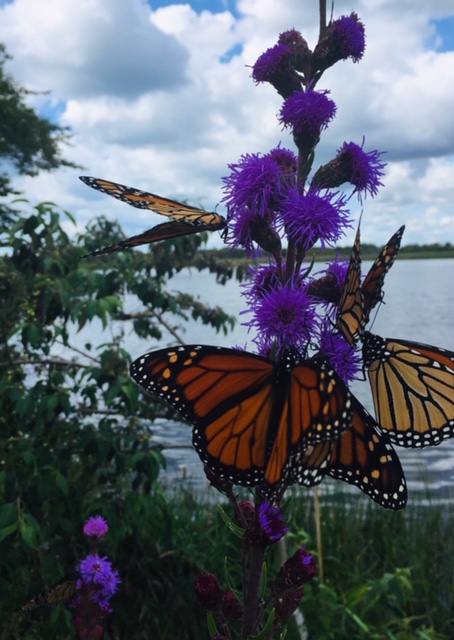Liatris also known as blazing star, looks spectacular in the August garden. It is a north american wildflower that is an attractive addition to the flower garden. It makes an excellent cut flower and as you can see from the illustration, it is a butterfly magnet.
We have had a hot humid, dry July. It has been a challenge to keep our gardens looking fresh and colourful. As August approaches, we are all hoping for some rain and fresher days so that garden tasks are easier to carry out. Northumberland Master Gardeners would like to share some to do’s for the Garden in August.
- Despite the lack of rain and the heat, the weeds just keep growing. Daily, they seem to increase by inches. Continuing the war on weeds is so important. Pulling a few each day will help you to keep on top of it. You definitely do not want the weeds to flower and seed as this will only multiply your weed problem.
- If you haven’t done so already, adding 2 to 4 inches of mulch to your garden beds will help keep your weeds at bay. It will also help your plants retain moisture. the mulch will break down and feed the soil, providing it with nutrients it needs. For mulch, you can use fallen leaves, pine needles, or finely ground wood chips. Keep the mulch a good inch away from stems of plant and trees.
- Keep deadheading your annuals and perennials. This will help to ensure that you have blooms through into fall. Some leggy perennials such as nepeta, salvia, and russian sage can use a “haircut”. If you sheer off the spent flowers, they will often come back in the fall with a second blush of blooms.
- Feed your dahlias. Every two weeks give them a high potassium feed, like tomato feed to boost their flowering. Keep them deadheaded to ensure more flowers. If you want giant flowers, or for cut flowers, nip out the smaller buds behind the central larger bud.
- A few hints to hasten the ripening of your tomato plants. Withhold water during the maturation stage and you might try plunging a border spade into the soil in a circle around the plant. By limiting how far the root system spreads, the plant will concentrate on setting fruit.
- The heat and humidity of summer put stress on your plants and make them more susceptible to diseases. Inspect your plants for diseased foliage and remove it. Do not put this waste in your compost, dispose of it in the garbage.
- When choosing plants for your garden next spring, keep in mind the flowers that tend to be resistant to the heat and humidity. These include coleus, hibiscus, zinnias, plumbago, and pentas.
- Keep harvesting your vegetables. Your zucchinis and cucumbers will be growing like mad. Pick the fruit while small and tender and share them with your friends.
- You may want to give your pots a makeover as some of the annuals planted in the spring begin to look worn out. You can carefully tuck in ready-to-bloom cool season annuals that will flower till fall. Pull out the spent annual, mix in a bit of fresh soil and drop in the replacement. Some examples of cool season annuals include calendula, osteospermum, aster, ornamental kale, purple fountain grass, marigolds and of course there will soon be lots of chrysanthemums available everywhere.
- August is the perfect time to divide perennials such as daylily, ornamental grasses, bearded iris, and oriental poppy. Use a spade to lift the the plant from the ground being careful to cause minimum damage to the root ball. When the clump is out of the ground, use a large garden knife or spade to cut the root ball into smaller pieces, replant the divisions as soon as possible. If the perennial has died out in the centre, remove the dead tissue and toss it into your compost heap.
- Take advantage of sales at the garden centres as August is the perfect time to plant perennials and flowering shrubs. They will take root during the cool moist weather of autumn and be ready to pop into bloom next spring and summer.
- Continue to take time to enjoy your garden. Stroll through your beds and cut some flowers to enjoy inside your home, harvest and eat the vegetables you have nurtured and of course enjoy a cold drink on your patio at the end of the day while you enjoy the sights, sounds and scents in your garden.

